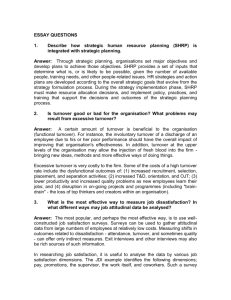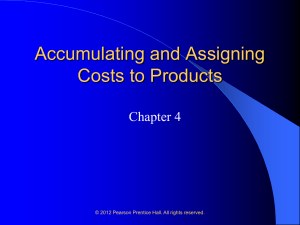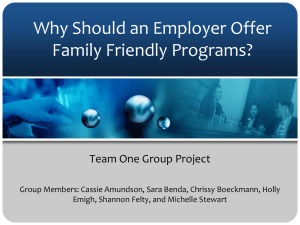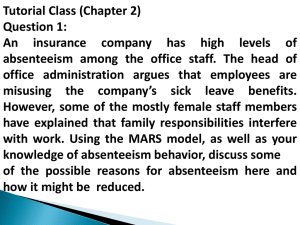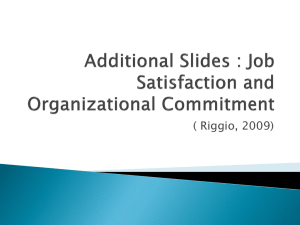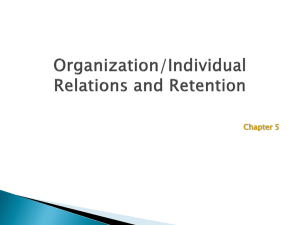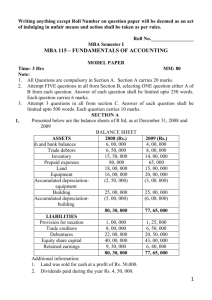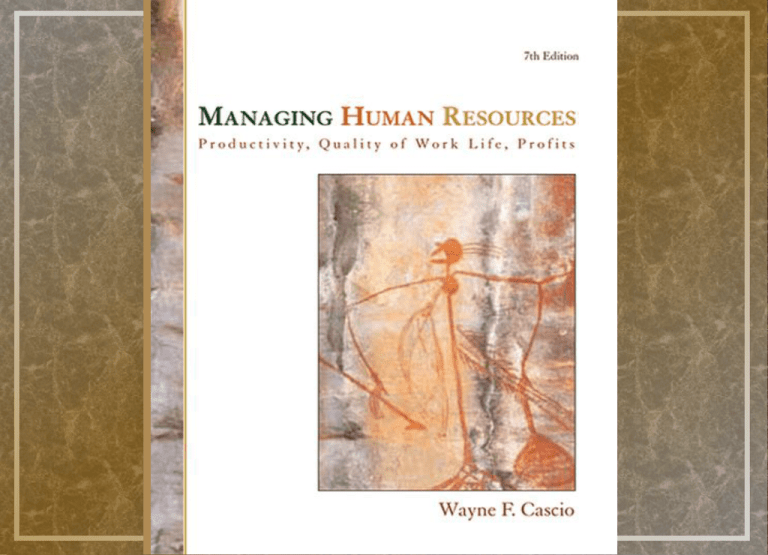
Chapter 2
The Financial Impact of Human Resource
Management Activities
McGraw-Hill/Irwin
© 2006 The McGraw-Hill Companies, Inc. All rights reserved.
Questions This Chapter Will Help Managers Answer
Can behavior costing help improve our business?
If I want to know how much money employee turnover is
costing us each year, what factors should I consider?
How do employees’ attitudes relate to customer satisfaction
and revenue growth?
Questions This Chapter Will Help Managers Answer
(contd.)
What’s the business case for work-life programs?
Is there evidence that high-performance work policies are
associated with improved financial performance?
Dimensions of HR Measurement Systems
Cost control – driving out costs in the HR
function and enhancing operational efficiency
outside of HR
Value Creation – ensuring that the HR
architecture (the continuum from HR professionals within the
HR function, to the system of HR-related policies and practices,
through the competencies, motivations, and associated behaviors
of the firm’s employees) intersects
with the process of
implementing strategy in the organization
Key Requirements of Human Capital (or HR)
Metrics
Evidence
Elements
Explanation
Purpose
Method
Key Requirements of Human Capital (or HR)
Metrics
Evidence – to establish that the effects of HR are indeed significant
enough to merit intensive measurement and study
Explanation – to provide a logical reason to suggest why and how
human resources create their significant effects on organizations
Purpose – the goals of measurement systems must consider the
effects of measures on key stakeholders within and outside the
organization
Method – a model and framework to support developing better HR
measures
How People Create Value
1. By enhancing return
2. By reducing risk
3. By increasing liquidity
Features of High-Performance Work Practices
Pushing responsibility down to employees operating in
flatter organizations
Increased emphasis on line managers as HR managers
Instilling learning as a priority in all organizational
systems
Decentralizing decision making to autonomous units and
employees
Linking performance measures for employees to financialperformance indicators
The Behavior Costing Approach
Assigns dollar estimates to behaviors,
such as absenteeism, turnover, and job
performance, of employees and
managers. Behavior costing does not
measure the value of an employee or
manager as an asset, but rather it
considers the economic consequences of
his or her behavior.
Table 2.1
Direct and Indirect Costs Associated with
Mismanaged Stress
Direct costs
Indirect costs
Participation and membership:
Absenteeism
Tardiness
Strikes and work stoppages
Loss of vitality:
Low motivation
Dissatisfaction
Performance on the job:
Quality of productivity
Quantity of productivity
Grievances
Communication breakdowns:
Decline in frequency of contact
Distortions of messages
Faulty decision making
Table 2.1
Direct and Indirect Costs Associated with
Mismanaged Stress (contd.)
Direct costs
Indirect costs
Accidents
Unscheduled machine downtime and
repair
Material/supply overutilization
Inventory shrinkages
Quality of work relations:
Distrust
Disrespect
Animosity
Compensation awards
Opportunity costs
Attitudes
… are internal states that focus on
particular aspects of or objects in the
environment.
Elements include:
cognition
emotion
action
Examples of Attitudes
Job Satisfaction – is a multidimensional attitude; it is
made up of attitudes toward pay, promotions, coworkers,
supervision, the work itself, and so on.
Organizational Commitment – a bond or linking of an
individual to the organization that makes it difficult to
leave.
Absenteeism
Any failure of an employee to
report for or to remain at work
as scheduled, regardless of
reason
Estimating the Weighted-Average Wage or Salary
Per Hour Per Absentee
Occupational Group
Approximate % of
Total Absenteeism
Average Hourly
Wage
Weighted Average
Wage
Blue-collar workers
.55
$23.05
$12.68
Clerical workers
.35
$18.20
$6.37
Mgt/Professional
.10
$36.50
$3.65
Total weightedaverage pay per
employee/hour
$22.70
Turnover
Any permanent departure beyond
organizational boundaries
The rate of turnover =
The number of turnover incidents per period
x 100%
Average work force size
Separation Costs
Exit interview
Administrative functions related to termination
Separation pay
Increased unemployment tax
Replacement Costs
Communicating job availability
Preemployment administrative functions
Entrance interview
Testing
Staff meetings
Travel and moving expenses
Postemployment acquisition and dissemination of information
Medical examinations
Training Costs
Informational literature
Instruction in a formal training program
Instruction by employee assignment
Work-Life Programs
A work-life program includes any
employer-sponsored benefit or working
condition that helps an employee to
balance work and non-work demands
Broad Areas of a Work-Life Program
Child and dependent-care benefits
Flexible working conditions
Leave options
Information services and HR policies
Organizational cultural issues
Key Behaviors of Best Managers
Select for talent
Find the right fit
Define the right outcomes
Focus on strengths
Key Terms Discussed in This Chapter
Human capital metrics
Behavior costing
Direct measures
Indirect measures
Controllable costs
Absenteeism
Turnover
Attitudes
Job satisfaction
Organizational commitment
Work-life program
Indirect measures of training
outcomes
Criteria
Transfer of trained skills
Break-even values
Control group design
Pre-test/post-test only design
Return on investment (ROI)
High performance work practices


